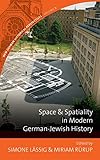Space and Spatiality in Modern German-Jewish History / ed. by Miriam Rürup, Simone Lässig.
Material type: TextSeries: New German Historical Perspectives ; 8Publisher: New York ; Oxford : Berghahn Books, [2017]Copyright date: ©2017Description: 1 online resource (340 p.)Content type:
TextSeries: New German Historical Perspectives ; 8Publisher: New York ; Oxford : Berghahn Books, [2017]Copyright date: ©2017Description: 1 online resource (340 p.)Content type: - 9781785335532
- 9781785335549
- Jews -- Germany -- History -- Congresses
- Jews -- Germany -- History -- 1800-1933 -- Congresses
- Space and time -- Religious aspects -- Judaism -- Congresses
- Space perception -- Germany -- History -- Congresses
- HISTORY / Jewish
- anthropologist
- anthropology
- architecture
- bavaria
- belgium
- berlin
- class struggle
- culture
- european history
- faith
- german film
- germany
- ghetto
- global
- hamburg
- holocaust
- holy
- jewish
- location
- memory
- miriam rurup
- munich
- nosferatu
- orthodox
- periodical
- philanthropy
- rabbi
- reform
- religion
- research
- russia
- sacred
- scholarly
- simone lassig
- society
- space
- spatial
- spirituality
- synagogue
- western europe
- world history
- zionism
- 943/.004924
- DS134.25 .S687 2017
- online - DeGruyter
| Item type | Current library | Call number | URL | Status | Notes | Barcode | |
|---|---|---|---|---|---|---|---|
 eBook
eBook
|
Biblioteca "Angelicum" Pont. Univ. S.Tommaso d'Aquino Nuvola online | online - DeGruyter (Browse shelf(Opens below)) | Online access | Not for loan (Accesso limitato) | Accesso per gli utenti autorizzati / Access for authorized users | (dgr)9781785335549 |
Frontmatter -- Contents -- Illustrations -- Preface -- Introduction: What Made a Space “Jewish”? Reconsidering a Category of Modern German History -- Part I Imaginations: Remembrance and Representation of Spaces and Boundaries -- 1 Of Sounds and Stones: The Jewish-Christian Contact Zone of a Swiss Village in the Nineteenth Century -- 2 Imaginations of the Ghetto: Jewish Debates on Ghettos and Jewish Society in Late Nineteenth-Century Galicia -- 3 Modernization and Memory in German-Jewish History -- 4 From Place to Race and Back Again: The Jewishness of Psychoanalysis Revisited -- 5 Jewish Displacement and Simulation in the German Films of E. A. Dupont -- 6 Layered Pasts: The Judengasse in Frankfurt and Narrating German-Jewish History after the Holocaust -- Part II Transformations: Emergences, Shifts, and Dissolutions in Spaces and Boundaries -- 7 The Representation and Creation of Spaces through Print Media: Some Insights from the History of the Jewish Press -- 8 Out of the Ghetto, Into the Middle Class: Changing Perspectives on Jewish Spaces in Nineteenth-Century Germany— The Case of Synagogues and Jewish Burial Grounds -- 9 Spatial Variations and Locations: Synagogues at the Intersection of Architecture, Town, and Imagination -- 10 Jewish Philanthropy and the Formation of Modernity: Baron de Hirsch and His Vision of Jewish Spaces in European Societies -- 11 Reconstructing Jewishness, Deconstructing the Past: Reading Berlin’s Scheunenviertel over the Course of the Twentieth Century -- Part III Practices: Negotiating, Experiencing, and Appropriating Spaces and Boundaries -- 12 A Hybrid Space of Knowledge and Communication: Hebrew Printing in Jessnitz, 1718–1745 -- 13 Faith in Residence: Jewish Spatial Practice in the Urban Context -- 14 Photography as Jewish Space -- 15 Jews, Foreigners, and the Space of the Postwar Economy: The Case of Munich’s Möhlstrasse -- 16 Creating a Bavarian Space for Rapprochement: The Jewish Museum Munich -- 17 Real Imaginary Spaces and Places: Virtual, Actual, and Otherwise -- Index
restricted access online access with authorization star
http://purl.org/coar/access_right/c_16ec
What makes a space Jewish? This wide-ranging volume revisits literal as well as metaphorical spaces in modern German history to examine the ways in which Jewishness has been attributed to them both within and outside of Jewish communities, and what the implications have been across different eras and social contexts. Working from an expansive concept of “the spatial,” these contributions look not only at physical sites but at professional, political, institutional, and imaginative realms, as well as historical Jewish experiences of spacelessness. Together, they encompass spaces as varied as early modern print shops and Weimar cinema, always pointing to the complex intertwining of German and Jewish identity.
Mode of access: Internet via World Wide Web.
In English.
Description based on online resource; title from PDF title page (publisher's Web site, viewed 25. Jun 2024)


